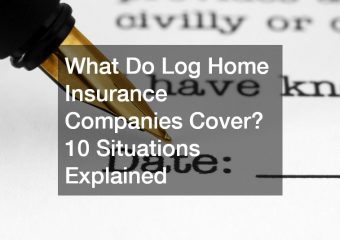
Log homes, with their quaint charm and unique architecture, offer a lifestyle close to nature. However, owning a log home also comes with its own set of challenges, especially when it comes to insurance coverage. Homeowners need to understand that log home insurance is not identical to standard home insurance. While the cozy essence of log homes is unbeatable, they require special attention and coverage compared to conventional houses. With the right policy from log home insurance companies, you can rest easy knowing that your cherished dwelling is protected against a multitude of risks.
The aim of this article is to provide clarity on what log home insurance companies typically cover. By examining ten specific scenarios, you will gain a comprehensive understanding of the various situations where your log home insurance can come into play. Whether dealing with natural disasters or mundane household issues, knowing the extent of your coverage can mean the difference between serenity and worry. It’s crucial to arm yourself with this knowledge to ensure your log home remains a place of comfort and safety for you and your family. Let’s dive into these situations and unravel the details of log home insurance coverage.

1. Replacement of Roofing Materials
The roof is undeniably one of the most significant components of any home, providing protection from the elements. Log home insurance companies can include coverage for the replacement of roofing materials. In many instances, the policy will outline specific terms regarding which materials are covered, such as aspahlt shingles. These shingles are a common choice due to their durability and cost-effectiveness. If you find yourself dealing with a leaky roof, having a well-crafted insurance policy can greatly ease financial burdens.
For log homeowners, keeping the roof in pristine condition is critical, and timely inspections are prudent. When damage occurs, whether from storms or gradual wear, understanding your policy’s coverage is vital. A comprehensive policy can help cover costs associated with hiring professionals for repairs or replacements. Furthermore, engaging with specialists can ensure that repairs are conducted in alignment with the structural integrity unique to log homes.
Log home insurance companies also encourage routine maintenance to prevent extensive damage, which can save homeowners from future complications. When selecting a policy, evaluate the terms regarding preemptive repairs and damages incurred over time. By doing so, you can confidently handle necessary upkeep while enjoying the peace the outdoors affords your log home.
2. Damage Due to Natural Disasters
Log homes, like any other dwellings, are susceptible to the whims of nature. Insurance companies provide varying levels of coverage for natural disasters depending on the region and likelihood of specific events. Understanding what is encompassed under these terms is crucial. For example, in areas prone to hurricanes or heavy snow, you might need a policy that includes specific provisions for wind or snow loads.
Flooding, a common outcome of natural disasters, can lead to severe damage, from a compromised foundation to a flooded basement. It is imperative to ascertain whether your policy covers water damage restoration, explicitly seeking out a water damage restoration service when needed. Detailed coverage can provide the needed financial aid for removing water, drying surfaces, and ultimately restoring the affected areas. The intricate construction of a log home means that choosing appropriate services and companies can make a beneficial difference.
Beyond natural occurrences, fires pose another significant risk. Insurance policies typically cover fire damage, but the specifics can vary greatly. Thus, close scrutiny of your policy and understanding what it explicitly offers is crucial. Knowing you are adequately insured can add a layer of protection and reduce stress during such incidents.

3. Electrical and HVAC System Breakdowns
The functionality of your home is highly dependent on efficient electrical and HVAC systems. Log home insurance companies understand this need and often include provisions for electrical repairs and HVAC repair in their policies. Given the remote location of many log homes, repair costs can escalate quickly, making insurance coverage a financial lifesaver.
More modern systems in log homes, such as a mini split heat pump, offer efficient heating and cooling solutions. These devices contribute to a more sustainable lifestyle, but they can also increase the complexity of repairs. Insurance policies that cover breakdowns or malfunctions of these systems ensure that your home’s comfort level remains intact without unexpected costs.
Carefully assess the scope of electrical and HVAC coverage in your policy and how it aligns with your home’s systems. Whether it’s repair techniques unique to the construction style or simple component replacements, understanding these terms means you’re not left out in the cold when an unexpected failure occurs.
4. Protection of Solar Investments
As homeowners become more environmentally conscious, many are turning to solar companies for renewable energy solutions. Installing solar panels on a log home can significantly reduce utility costs while promoting sustainability. However, these installations are susceptible to various risks and damages, which leads to the need for adequate insurance coverage.
Log home insurance companies often provide specific clauses covering solar panels against weather damage, vandalism, or system failure. Additionally, if you have a house battery backup to complement your solar setup, ensuring this is covered can provide further assurance. Policies might cover damages incurred during storms or from errant debris, safeguarding your investment in green energy.
When considering installing solar solutions, closely review existing insurance plans and discuss your options with your provider. Understanding whether solar company installations are covered under general home insurance or require additional riders will offer peace of mind and secure the benefits of your solar investment.

5. Coverage for Landscaping and Outbuildings
The aesthetics and functionality of a log home are often enhanced by its surrounding landscape and outbuildings. Whether it’s a picturesque garden or essential sheds, insurance policies can vary in what they include. Log home insurance often takes into account the unique nature of properties, extending coverage to these valuable additions.
Storms, fires, or vandalism can cause significant damage to outbuildings and landscapes, creating unexpected financial strain. Insurance policies that extend coverage to these areas can mitigate potential losses. Reviewing terms for coverage specific to your external structures ensures that essential spaces are considered within the plan.
If your policy covers landscaping, it typically accounts for expenses related to plant replacements or repairs to hardscape elements. Ensuring your beloved creations and structures are protected allows you to invest further in the beauty and utility of your log home’s surroundings without hesitation.
6. Managing Moisture and Mold Issues
Log homes are often praised for their ideal living environments; however, they are not immune to issues related to moisture. In particular, mold is a recurrent issue that can affect health and the structural integrity of the home. Log home insurance companies understand this potential and often offer mold coverage within their policies.
Insurance often covers the costs associated with a mold removal service, which typically involves remediation and preventive measures. Catching mold early is crucial, and immediate professional intervention can mitigate its spread and potential damage. Policies usually include coverage for situations where water intrusion, like from a leaky roof, may have led to mold development.
Understanding your policy’s coverage extent for water damage and mold claims helps address issues promptly, keeping your log home both safe and healthy. Always ensure that the reviewed policy makes provisions for these types of repairs, maintaining a mold-free living environment for your family to enjoy.

7. Coverage for Interior Water Damage
Water damage poses a significant threat to log homes, whether from malfunctioning appliances or severe weather conditions. Log home insurance companies typically include coverage for a water damage restoration service, offering financial relief in such events.
Understanding the policy is essential, as water damage covered by insurance often pertains to rapid and accidental occurrences. This may include incidents like pipe bursts or water intrusion during heavy storms, in which case the coverage will help with cleaning, repair, and restoration expenses. If prompt action is taken during water damage, further problems such as mold can be avoided.
Insurers also highlight the importance of regular maintenance to prevent avoidable issues, such as inspecting plumbing and sealing windows. Taking proactive measures ensures the well-being of the home and may positively influence your insurance terms. Knowing you have coverage for unexpected water incidents can bring comfort and security to log homeowners.
8. Restoring Home After Fire Damage
Fire is a devastating event for any home, but the risk is amplified in a log home due to the materials involved. Log home insurance companies generally include coverage for fire damage, which can significantly ease the restoration process.
When a fire occurs, extensive damage to structures and personal property might be expected. Insurance policies covering fire damage aid in repairing or reconstructing the compromised sections of your home. They also often contribute to temporary living expenses if the home is inhabitable during repairs.
Evaluating the extent of fire damage coverage in an insurance policy gives homeowners insight into what they can expect financially in such unfortunate circumstances. Discussing the potential hazards and prevention with your insurer can enhance your protection, letting you maintain a safer, more secure environment.
9. Liability Protection
Log home insurance companies frequently extend liability protection, covering events where the homeowner is legally responsible for another party’s injury or damage incurred on the property. This essential coverage offers significant security and peace of mind.
Liability coverage includes situations like guest injuries caused by unsafe conditions on the property, for which the homeowner might be held accountable. Having appropriate insurance ensures that the medical expenses or legal fees do not directly impact the homeowner’s finances. It essentially safeguards against potential financial ruin from unpredictable incidents.
Understanding the limits and exceptions of your liability coverage is vital, as policies might have specific thresholds or exclusions. As a homeowner, ensuring your property is safe and well-maintained can proactively prevent incidents, enhancing the benefits gained from your liability protection.
10. Additional Living Expenses
Additional living expenses (ALE) coverage is an important aspect of log home insurance policies, providing support if your home becomes uninhabitable due to insured perils. This benefit helps cover costs associated with temporary housing, meals, and other necessary arrangements while your log home is being repaired.
For many insurance policies, ALE coverage kicks in when events like severe water or fire damage make it impossible for you to live in your home safely. Understanding the exact terms, limitations, and conditions that trigger ALE is crucial for planning any extended stay away from your home.
Acknowledging these potential costs and how they are managed can bring assurance, knowing unforeseen hardships won’t lead to financial distress. Policies with robust ALE clauses provide an insightful investment in securing family stability, even when unexpected issues arise, allowing your log home dreams to continue uninterrupted.
Owning a log home offers a unique living experience, but it also introduces specific challenges, especially in terms of insurance coverage. Log home insurance companies provide tailored policies that cover multiple scenarios to protect your home against unforeseen incidents. We’ve explored how these policies cater to issues ranging from roof replacements with asphalt shingles to dealing with leaky roofs, engaging with solar companies, or maintaining house battery backups. Coverage extends to modern amenities like mini split heat pumps, addressing HVAC repair, and includes essential services such as mold removal service and water damage restoration service.
Beyond these services, addressing fire damage or navigating the complexities of a flooded basement demonstrates the thoroughness of well-structured policies. As we’ve seen, having sound insurance adds a crucial layer of protection, leaving homeowners confident that they can handle potential difficulties without financial panic. Log home insurance also encompasses liability protection and additional living expenses, reinforcing the significance of evaluating your policy options effectively.
Ultimately, engaging proactively with insurance experts and carefully reviewing your coverage allows you to enjoy the full essence of your log home. With comprehensive protection provided by reputable log home insurance companies, you can maintain the idyllic lifestyle that comes with owning a log home, knowing that you are well-prepared for whatever challenges may arise.



